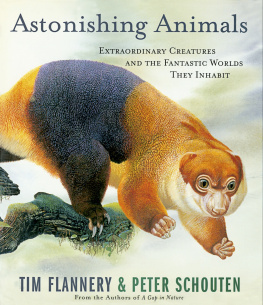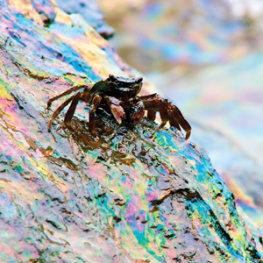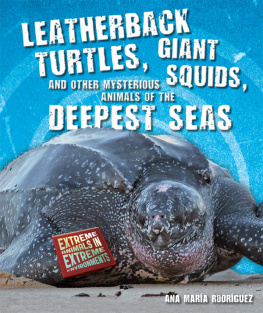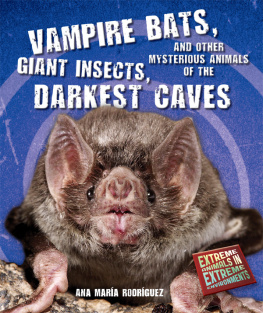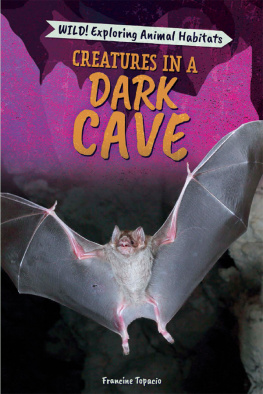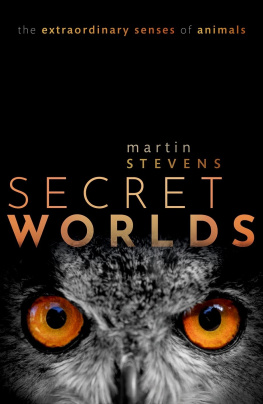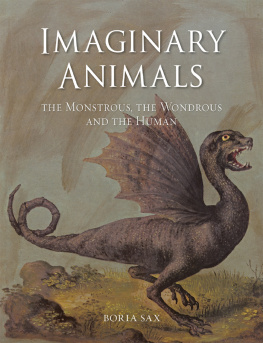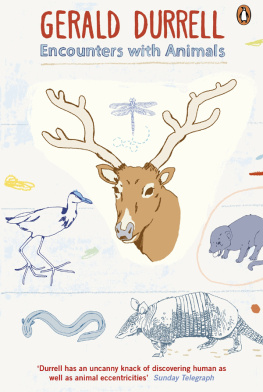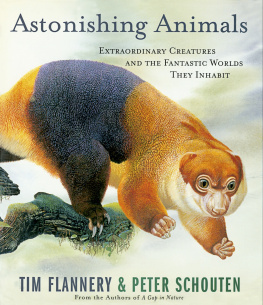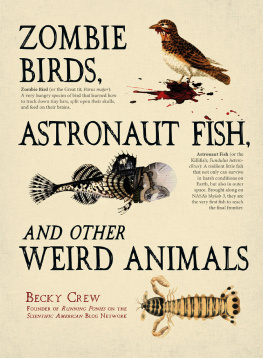

Pygmy narrow-mouthed frog
(actual size)
Astonishing
Animals
E XTRAORDINARY C REATURES AND THE
F ANTASTIC W ORLDS T HEY I NHABIT
T IM F LANNERY & P ETER S CHOUTEN

Atlantic Monthly Press
New York
OTHER BOOKS BY THE AUTHORS
Possums of the World: A Monograph of the Phalangeroidea
Tree Kangaroos: A Curious Natural History with R. Martin & A. Szalay
A Gap in Nature: Discovering the World's Extinct Animals
TIM FLANNERY
Mammals of New Guinea
The Future Eaters: An Ecological History of the Australasian Lands and People
Mammals of the South West Pacific and Moluccan Islands
Watkin Tench, 1788 ed.
The Life and Adventures of John Nicol, Mariner ed.
Throwim Way Leg: Tree-Kangaroos, Possums, and Penis Gourds On the Track of Unknown Mammals in Wildest New Guinea
The Explorers: Stories of Discovery and Adventure from the Australian Frontier ed.
The Birth of Sydney ed.
Terra Australis: Matthew Flinders Great Adventures in the Circumnavigation of Australia ed.
The Eternal Frontier: An Ecological History of North America and Its Peoples
The Life and Adventures of William Buckley ed.
The Birth of Melbourne ed.
Joshua Slocum, Sailing Alone around the World ed.
PETER SCHOUTEN
Prehistoric Animals of Australia, S. Quirk & M. Archer eds.
The Antipodean Ark: Creatures from Prehistoric Australia, S. Hand & M. Archer eds.
Text copyright 2004 by Tim Flannery
Illustrations copyright 2004 by Peter Schouten
All rights reserved. No part of this book may be reproduced in any form or by any electronic or mechanical means, including information storage and retrieval systems, without permission in writing from the publisher, except by a reviewer, who may quote brief passages in a review. Any members of educational institutions wishing to photocopy part or all of the work for classroom use, or publishers who would like to obtain permission to include the work in an anthology, should send their inquiries to Grove/Atlantic, Inc., 841 Broadway, New York, NY 10003.
First published in Australia in 2004 by The Text Publishing Company
Published simultaneously in Canada
Printed and bound in China through Bookbuilders, Hong Kong
FIRST AMERICAN EDITION
Library of Congress Cataloging-in-Publication Data
Flannery, Tim F. (Tim Fridtjof), 1956
Astonishing animals : extraordinary creatures and the fantastic worlds they inhabit / Tim Flannery ; with illustrations by Peter Schouten.
p. cm.
ISBN 9780802194176
1. Vertebrates. 2. VertebratesPictorial works. I. Title.
QL605 .F64 2004
590dc222004051712
Book designed by Chong Wengho
Atlantic Monthly Press
841 Broadway
New York, NY 10003
04 05 06 07 0810 9 8 7 6 5 4 3 2 1
To
Bert (Lambertus) Schouten
Father, Mentor, Artist
Contents
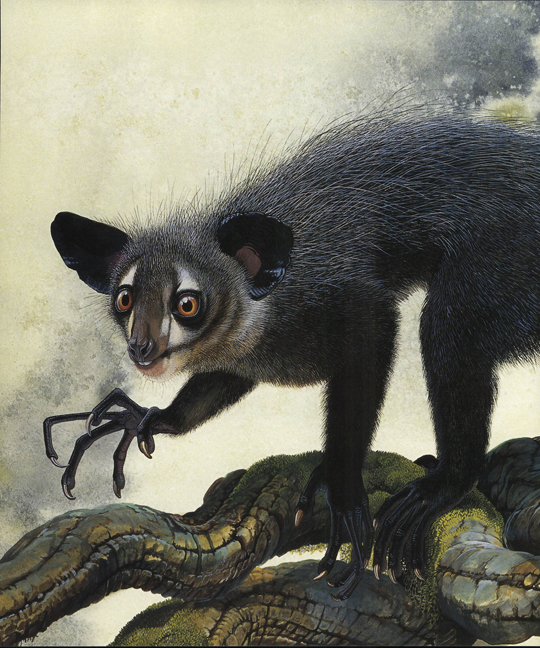
Life: A Brief Biography
by Tim Flannery
EVER SINCE the spark of life first flashed into existence on our planet, living things have expanded their domain, invading and making one habitat after another their own. The result has been a triumph of evolutionary change and a world of organisms so complex and varied that all living things should really be regarded as astonishing. Some living things, however, lead such different lives from the ones we have experience of that, from our narrow vantage point on the land, they appear almost alien. The ninety-seven creatures that populate these pages represent, in one way or another, the outer limits of life's progress, and astonishing creatures they are indeed.
Despite three and a half billion years of evolutionary invasion and advance, the realm of life remains circumscribed, for it's still only the skin of our heavenly sphere that is softened with a dusting of living things. The bacteria and other micro-organisms have ventured farthest. Some eke out an existence in the pores of rocks situated around ten kilometres in the Earth's crust, while others are regularly hoisted by winds and currents a similar distance into the upper atmosphere.
Multi-celled animals, however, can exist only in a small part of this life-zone, and vertebratesthe creatures that are the focus of this bookare even more limited in their distribution. Despite the fact that man has touched the Moon, and vultures have collided with passenger jets 11,300 metres above the Earth, vertebrates can thrive only in a zone that ranges from the bottom of the Marianas Trench (a depth of around 11.2 kilometres) to a height of around 6400 metres in the Himalayas. The record for deep-living is held by an unidentified flatfish which was glimpsed by two submariners through the tiny window of a submersible as it touched down at the deepest point on Earth. In contrast there is a small, dull bird known as the wall-creeper ( Typodroma muraria ) which hops about among the bare rocks and scree slopes that sherpa Norgay Tensing and Edmund Hillary traversed in order to conquer Mount Everest. It says much about our ignorance of this living planet that we cannot identify the
fish glimpsed at the bottom of the ocean, and that the next deepest record of a fish is from two kilometres nearer the surfacean undistinguished bag-like creature known as Bassogigas profundus.
If these are the geographical extremes to which life has pushed, there are other extremes as wellextremes of diet, of reliance on mysterious senses, and of sexual attraction. And it is the vibrant success of living things and their myriad ecological niches that has inspired this book.

Before embarking on our investigation of these natural wonders it is necessary to trace life's long journey, from its obscure origins to its present success, for only then will we see these creatures in context. The expansion of life in time and space is, according to evolutionary biologist Michael Archer, the saga of a four-dimensional bio-blob (the fourth dimension being time), which is forever ramifying, splitting and terminating at the ends as it weaves its way through the obstacle course of extinction and opportunity that Earth has provided. Because all life shares a single origin, that bio-blob had to begin somewhere, and at some specific time, yet our knowledge of these matters remains frustratingly dim. Even the fundamental issue of which planet life originated on cannot be resolved at present, for some astronomers hold firmly to the view that life began on Mars and was carried inside rocks blasted from the red planet's surface some four billion years ago.
Wherever its ultimate origin, life must have taken hold at a specific time and a specific place on the Earth's surface. It seems to have done this so long ago, however, that at our current remove in time we have little hope of pinpointing that origin. Almost no rocks survive from that distant period, and many of those that remain are so distorted by pressure and heat as to have destroyed all fossils. And, of course, any fossils would be microscopic and simple in structure. These difficulties, and many others, mean that we may be doomed to live with an uncertainty of hundreds of millions of years in pinpointing the moment that earthly life began.
Next page
